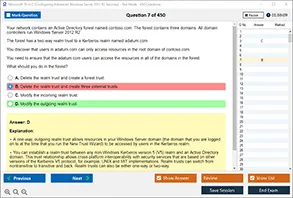Introduction
In computer networking, data transmission involves a series of complex processes before an IP packet reaches its destination. Understanding these processes is crucial for network engineers, especially those preparing for the Cisco 200-301 CCNA exam. This article explores the step-by-step procedures an IP packet undergoes before being transmitted over the physical medium. Additionally, we will discuss the relevance of this topic in the Cisco 200-301 certification and how resources like DumpsArena can help aspiring candidates master these concepts effectively.
Understanding IP Packets and Their Transmission
An IP (Internet Protocol) packet is a fundamental unit of data transmitted across networks. Before an IP packet is sent over a physical medium (such as Ethernet cables or wireless signals), it undergoes several critical steps, including:
- Data Encapsulation
- Segmentation and Fragmentation (if necessary)
- Addressing with IP and MAC
- Error Checking and Correction
- Conversion into Frames for Physical Transmission
Each of these steps ensures reliable and efficient data delivery across networks.
Step 1: Data Encapsulation in the OSI Model
The OSI (Open Systems Interconnection) model defines how data is prepared for transmission. Before an IP packet is sent, it passes through multiple layers, each adding necessary control information:
- Application Layer (Layer 7): The data is generated by applications (e.g., HTTP, FTP).
- Transport Layer (Layer 4): The data is segmented into smaller chunks. TCP (Transmission Control Protocol) or UDP (User Datagram Protocol) adds source and destination port numbers.
- Network Layer (Layer 3): The IP header is added, containing source and destination IP addresses.
- Data Link Layer (Layer 2): The packet is converted into a frame, with MAC addresses added for local network delivery.
- Physical Layer (Layer 1): The frame is converted into bits (0s and 1s) for transmission over the physical medium.
This process is known as encapsulation, where each layer adds its own header (and sometimes trailer) before passing it down.
Step 2: Segmentation and Fragmentation
Segmentation (Transport Layer - TCP/UDP)
- If data is too large, TCP breaks it into smaller segments.
- Each segment includes a sequence number for reassembly at the destination.
Fragmentation (Network Layer - IP)
- If an IP packet exceeds the Maximum Transmission Unit (MTU) of a network, routers may fragment it.
- The receiving device reassembles fragments using fields in the IP header (Identification, Flags, Fragment Offset).
Step 3: Addressing – IP and MAC
Before transmission, the packet must have:
IP Addressing (Layer 3)
- The source and destination IP addresses determine the end-to-end delivery path.
MAC Addressing (Layer 2)
- Since IP addresses are logical, devices use ARP (Address Resolution Protocol) to find the MAC address of the next hop (router or destination).
- The Data Link layer adds source and destination MAC addresses to the frame.
Step 4: Error Checking and Correction
To ensure data integrity:
- Checksums (TCP/UDP Headers): Verify if data was corrupted during transmission.
- CRC (Cyclic Redundancy Check - Data Link Layer): Detects errors in frames before transmission.
If errors are detected, the packet may be retransmitted (in TCP) or discarded (in UDP).
Step 5: Conversion into Frames and Physical Transmission
Finally, the Data Link layer converts the packet into a frame with:
- Header (MAC addresses, control info)
- Payload (IP packet)
- Trailer (CRC for error detection)
The Physical layer then converts the frame into electrical signals (wired) or radio waves (wireless) for transmission.
Role in Cisco 200-301 CCNA Exam
This topic is critical for the Cisco 200-301 CCNA exam, particularly in sections like:
- Network Fundamentals (OSI model, IP addressing)
- IP Connectivity (routing, fragmentation)
- Network Access (Ethernet, MAC addressing)
Candidates must understand:
- How encapsulation works across OSI layers
- The role of ARP in MAC resolution
- How MTU affects packet fragmentation
Mastering these concepts ensures success in Cisco simulation-based questions and real-world networking scenarios.
How DumpsArena Helps in CCNA 200-301 Preparation?
For aspiring Cisco professionals, DumpsArena provides high-quality exam dumps, practice tests, and study guides that cover:
- Detailed explanations of IP packet transmission
- Real exam-like questions
- Hands-on lab scenarios
- Updated Cisco 200-301 syllabus coverage
By using DumpsArena’s resources, candidates can:
- Gain confidence in networking concepts
- Identify weak areas through practice tests
- Pass the Cisco exam in the first attempt
Conclusion
Before an IP packet is transmitted over the physical medium, it undergoes encapsulation, addressing, error checking, and frame conversion. These steps ensure reliable data delivery across networks. For Cisco 200-301 CCNA aspirants, mastering these concepts is essential. Platforms like DumpsArena provide the necessary study materials to excel in the exam and build a strong networking foundation.
By understanding these processes, network engineers can troubleshoot connectivity issues efficiently and design robust network infrastructures.
Get Accurate & Authentic 500+ CCNA 200-301 Exam Questions
1. What is the first step in preparing an IP packet for transmission over the physical medium?
A) Encapsulation into a frame
B) Segmentation into smaller pieces
C) Addition of a transport layer header
D) Conversion into binary signals
2. Which layer of the OSI model is responsible for encapsulating an IP packet into a frame?
A) Network Layer
B) Data Link Layer
C) Physical Layer
D) Transport Layer
3. Before transmission, an IP packet is encapsulated with which of the following?
A) Only a header
B) Only a trailer
C) Both a header and a trailer
D) A checksum field
4. What is the purpose of the Frame Check Sequence (FCS) in a data frame?
A) To identify the source and destination IP addresses
B) To detect errors in the transmitted frame
C) To encrypt the data for security
D) To compress the packet for faster transmission
5. Which of the following is added to an IP packet to form a frame at the Data Link Layer?
A) MAC addresses
B) Port numbers
C) Sequence numbers
D) TTL (Time to Live)
6. Before transmission, the data is converted into:
A) Packets
B) Frames
C) Binary signals (bits)
D) Analog signals
7. Which of the following is NOT a step in preparing an IP packet for physical transmission?
A) Encapsulation into a frame
B) Error detection using FCS
C) Packet routing based on IP address
D) Conversion into electromagnetic signals
8. What is the role of the Physical Layer in transmitting an IP packet?
A) Adding source and destination MAC addresses
B) Converting frames into bits for transmission
C) Encrypting the data for security
D) Fragmenting the packet into smaller pieces
9. Which field in a frame helps in identifying the type of payload (e.g., IPv4, IPv6)?
A) MAC Address
B) EtherType
C) FCS
D) TTL
10. What happens if a frame fails the FCS error check before transmission?
A) The frame is forwarded anyway
B) The frame is retransmitted
C) The frame is discarded
D) The frame is sent to a different destination




